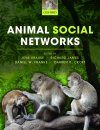![Animal Social Networks Animal Social Networks]()
Click to have a closer look
About this book
Contents
Customer reviews
Biography
Related titles
About this book
The scientific study of networks – computer, social, and biological – has received an enormous amount of interest in the last few years. However the network approach has been applied to the field of animal behaviour relatively late compared to other biological disciplines. Understanding social network structure is of great importance for biologists because the structural characteristics of any network will affect its constituent members and influence a range of diverse behaviours, such as finding and choosing a sexual partner, developing and maintaining cooperative relationships, and engaging in foraging and anti-predator behavior.
This edited volume provides an overview of the insights that network analysis has provided into major biological processes, and how it has enhanced our understanding of the social organisation of several important taxonomic groups. It brings together researchers from across disciplines with the aim of providing both an overview of the power of the network approach for understanding patterns and process in animal populations, and outlining how current methodological constraints and challenges can be overcome.
Contents
Section I: Introduction
1: General Introduction
2: Network Primer
Section II: Patterns and Processes
3: Assortment in social networks and the evolution of cooperation
4: Mating behaviour: Sexual networks and sexual selection
5: Quantifying diffusion on social networks: a Bayesian Approach
6: Personality and social network analysis in animals
7: Temporal changes in dominance networks and other behavior sequences
8: Group movement and social networks
9: Communication
10: Disease transmission
11: Social networks and animal welfare
Section III: Taxonomic Overviews
12: Primate social networks
13: Oceanic societies: Studying cetaceans with a social networks approach
14: The network approach in teleost fishes and elasmobranchs
15: Social networks in insect colonies
16: Perspectives on social network analyses of bird populations
17: Networks of terrestrial ungulates: linking form and function
18: Linking lizards: Social networks in reptiles
19: General Conclusion
Customer Reviews
Biography
Jens Krause is professor of fish biology and ecology at Humboldt University, Germany. He has published over 150 papers and several books on topics such as collective behaviour, social networks and swarm intelligence.
Richard James is a senior lecturer at the University of Bath, UK. His research interests centre around the development and use of computational models and analyses to interpret biological data.
Dan Franks is lecturer in the department of biology and the department of computer science at the University of York, UK. He has published on topics such as social networks, collective behaviour, life-history evolution, and predator-prey evolution.
Darren Croft is a senior lecturer in animal behaviour at the University of Exeter, UK. His research focuses on the ecology and evolution of group-living and he has published over 50 papers in leading international journals and is lead author on a monograph titled Exploring Animal Social Networks.
By: Jens Krause(Editor), Richard James(Editor), Daniel W Franks(Editor), Darren P Croft(Editor)
288 pages
"Animal Social Networks is a substantial contribution to the literature on social interactions in animal behaviour."
– Phil Stephens, BES Bulletin 46(4), December 2015
"Served by an excellent use of various helpful illustrations (matrices, diagrams, flowcharts, and actual social networks) and a few formulas of mathematical models, this thorough reference book will resonate well with a broad readership, including ethologists, ecologists, and evolutionary biologists. [...] Essential."
– CHOICE
"[F]or those curious about how social network analyses might at some future point contribute to a better understanding of complex behavioral interactions among group (however broadly defined) members, Animal Social Networks is a valuable resource."
– Harold Gouzoules, Integrative and Comparative Biology



































